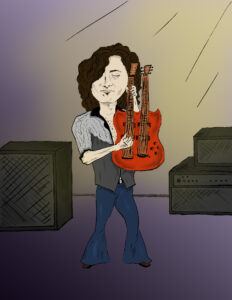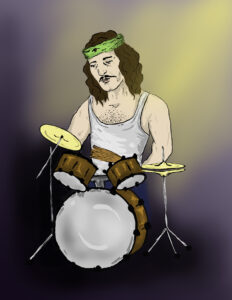Even on the first Zeppelin recording sessions, Jimmy Page’s vast studio experience made him a master of production and sound design. Page was one of the first to record the ambient sound of a rock band. Page would also experiment with microphone placement. He often placed a mic ten or fifteen feet behind an amp as well as directly in front. This was known as “distance equals depth” which became very common in rock recording. Page stated, “The whole idea is to try and capture the sound of the room live and the emotion of the whole moment and try to convey that….You’ve got to capture as much of the room sound as possible. That’s the very essence of it.”
Page used an enormous collection of guitars throughout his career. Jeff Beck had given Jimmy a 1959 Fender Telecaster when Page first joined The Yardbirds and that became Jimmy’s main guitar for quite some time. His guitar sound changed from a Telecaster on Led Zeppelin I to a Les Paul on Led Zeppelin II. After recording some of the “Stairway To Heaven” passages on separate six and twelve string guitars, a problem surfaced. How would Page bring “Stairway to Heaven” from the studio to the concert stage? Page said, “I’d recorded the thing and then wondered how I was going to do it.” The solution was found with an incredible instrument that was custom made for him by Gibson, the EDS 1275, which combined a 12 string and a six-string guitar on one double-necked instrument. The EDS 1275 was a 34 lb. cherry mahogany double-necked axe that was as stunning to look at as it was to play. This guitar appeared in many Zeppelin concert photos.
Big Quote – Jimmy Page on Zeppelin being referred to as a heavy metal band:
“I can’t relate that (heavy metal) to us because the thing that comes to mind when people say heavy metal is riff-bashing, and I don’t think we did that. It was always inner dynamics, light and shade, drama and versatility that we were going for” – Jimmy Page
Page became famous for his live use of a violin bow on his guitars to create unique improvised solos and add an eerie, mystical quality to many Zeppelin songs. On an early pre-Yardbirds recording session with the Royal Philharmonic Orchestra, their principle violinist, David McCallum, asked Jimmy if he had ever bowed his guitar. Jimmy replied, “It wouldn’t work because the strings aren’t arched over the guitar the way they are over the violin. But, McCallum said ‘Have a go.’ So I tried it and realized there might be something in it. I don’t remember if I used it on any sessions, but I certainly used it the minute I was in The Yardbirds.”
As a songwriter, Page knew what his contributions should be, and limited his input in writing lyrics. Whether it was acoustic or electric, he usually focused on writing the music first. Sometimes he did write the lyrics for songs such as “Good Times, Bad Times.” For that tune he wrote the lyrics for the chorus, and Plant wrote the lyrics for the verses. Page gave further insight into Zeppelin’s songs when he said, “One of the things that you’ll see in Led Zeppelin music is that every song is different from the others. Each one has its own character, musically as much as lyrically. The music was really of paramount importance to setting the scene and most probably inspired the singer, in this case Robert, to get set into the overall emotion, the ambience of the track of what was being presented, and then hopefully inspired him to write the lyrics.”
Jimmy Page, the complete rock musician.

